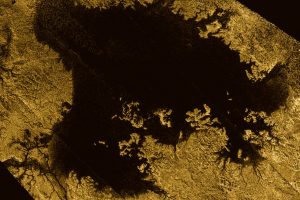オリジナル記事:Rays of Creusa
When viewed from a distance with the sun directly behind Cassini, the larger, brighter craters really stand out on moons like Dione.
NASAの土星探査機カッシーニが、背後からの太陽光が衛星ディオネを照らし出す位置にくると、大きく、光り輝くクレーターを実によく観測できます。
Among these larger craters, some leave bright ray patterns across the moon, calling attention to their existence and to the violence of their creation.
それらの大きなクレーターは、いくつもの光り輝く放射線状の軌跡を衛星全体に拡げ、あたかも自らの存在とクレーター形成時の衝撃の凄まじさを誇示しているかのようです。
The rayed crater seen here on Dione (698 miles, or 1,123 kilometers across) is named Creusa. The rays are brighter material blasted out by the impact that formed the crater. Scientists can use the patterns of ejecta (like these rays), to help determine the order of geological events on a moon’s surface by examining which features lie on top of other features.
衛星ディオネ(直径698マイル、または1,123キロ)に見える大きな放射線状の軌跡を見せているクレーターがクレウサです。放射線状の軌跡は明るく輝く物質によるものでクレーター形成時の衝撃により噴出されたものです。科学者たちはその輝いて見えている軌跡から、他の地表の上に拡がった地表の特徴を解析してディオネの地質学的な変遷を明らかにしていきます。
This view looks toward the Saturn-facing side of Dione. North on Dione is up and rotated 31 degrees to the right. The image was taken with the Cassini spacecraft narrow-angle camera on Nov. 26, 2016 using a spectral filter which preferentially admits wavelengths of near-infrared light centered at 727 nanometers.
この画像はディオネの土星に面した側のものです。ディオネの北の方角が画像の上部で、右に31度回転しています。2016年11月26日にカッシーニ搭載の狭角カメラで、727ナノメートルを中心とする近赤外光の波長のスペクトルフィルタを用いて撮影されました。
The view was obtained at a distance of approximately 350,000 miles (560,000 kilometers) from Dione. Image scale is 1.8 miles (3 kilometers) per pixel.
この画像はディオネからおよそ350,000マイル(56万km)の距離で撮影したものです。画像解像度はピクセルあたり1.8マイル(3キロメートル)です。
The Cassini mission is a cooperative project of NASA, ESA (the European Space Agency) and the Italian Space Agency. The Jet Propulsion Laboratory, a division of the California Institute of Technology in Pasadena, manages the mission for NASA’s Science Mission Directorate, Washington. The Cassini orbiter and its two onboard cameras were designed, developed and assembled at JPL. The imaging operations center is based at the Space Science Institute in Boulder, Colorado.
For more information about the Cassini-Huygens mission visit http://saturn.jpl.nasa.gov and http://www.nasa.gov/cassini. The Cassini imaging team homepage is at http://ciclops.org.
Credit: NASA/JPL-Caltech/Space Science Institute
Last Updated: Feb. 22, 2017
Editor: Tony Greicius









